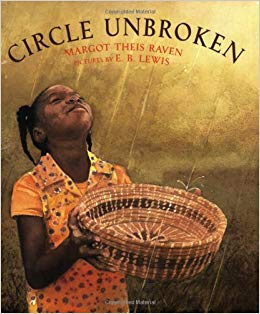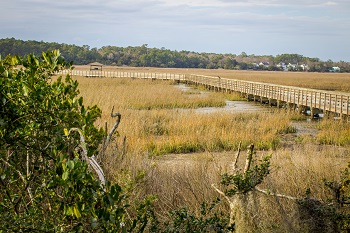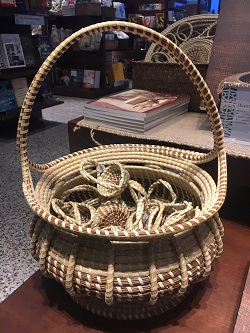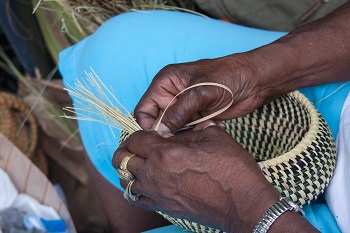 Circle Unbroken: The Story of a Basket and Its People
Circle Unbroken: The Story of a Basket and Its People
Grades K-2 and 3-5
Written by: Margot Theis Raven
Illustrated by: E.B. Lewis
Published by: Square Fish, New York, 2004
ISBN-13: 978-0312376031
Recommended Reading
A young girl sits in her grandmother’s lap and learns how to sew a basket made of natural sweetgrass. The grandmother recounts that the history of this practice goes all the way back to the riverbanks of Africa, where tall reeds growing along the water were used for many things.
She tells a tale going back generations to her grandfather’s village in West Africa. One of her male ancestors was challenged by village elders to “bring water in a basket” to demonstrate he was ready to transition into adulthood. He had to learn how to make a basket from what nature could readily provide, an abundance of dried grass.

Small Circular Basket Holds Big Circle of African-American History
The sweetgrass coil – or Gullah basket – is an ancient art form. Its design traveled to the Southern United States with West African descendants in the time of slavery, as early as the 1700s. Coil basketry found a place in the Lowcountry of South Carolina and Georgia where coastal islands harbor similar sea-grass vegetation to Africa’s West Coast.
Teaching Extensions
Circle Unbroken explains the importance of tradition and history and how these concepts are both affected by the forces of time and place and yet, at other times, remain steadfast against them.
Use this grandmother’s story and the art of Gullah baskets to teach about:

Nature-based Products
Grandmother’s story details many examples of how her ancestors used items they found or grew in nature to make products for their village; from food to tools and instruments. Find examples of these items in the text. Which do you have in your school, your home, and your community?
World History
This book and its beautiful watercolor illustrations cover several hundred years of African-American history, from African enslavement and westward expansion through the American civil wartime and the fight to emancipate slaves. If you live in the United States, it is likely your family emigrated from somewhere; if not Africa, maybe Europe or Asia. Use this opportunity to ask your grandparents about their grandparents. When did they come to America, where from, and why?
Traditions
 Grandmother describes different emotions her ancestors felt as young children, as they were forced to leave their African homeland and move to the unfamiliar Americas. Weaving Gullah baskets in a new and strange place brought them strength and comfort. What are your family’s traditions? Why do you continue to do them? How do they make you feel?
Grandmother describes different emotions her ancestors felt as young children, as they were forced to leave their African homeland and move to the unfamiliar Americas. Weaving Gullah baskets in a new and strange place brought them strength and comfort. What are your family’s traditions? Why do you continue to do them? How do they make you feel?
Personal Pilgrimage
This book discreetly mentions the male and female societal schools of the Sierra Leone’s Mende and Temne tribes, in the sacred Poro-Sande bush. Young men and women attend these bush schools as they learn the skills required to enter adulthood. In Australian Aboriginal society, a similar rite of passage ceremony is called “Walkabout.” What skills have you learned that will help you in adulthood? Think of a journey you’ve been on, discuss its related challenges, and lessons learned from them.
Connections to PLT Activities
Consider coupling this story with the following PLT activities to deepen student understanding of world history, art, and tradition:
Environmental Experiences for Early Childhood
#3 Get in Touch with Trees
#4 We All Need Trees
#11 Three Cheers for Trees
PreK-8 Environmental Education Activity Guide
#17 People of the Forest
#18 Tale of the Sun
#40 Then and Now
#76 Tree Cookies
#90 Native Ways
#91 In the Good Old Days
#92 A Look at Lifestyles
#94 By the Rivers of Babylon


